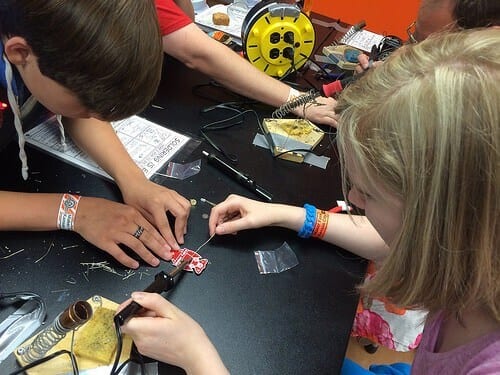When I was growing up in Minnesota in the 1960s, “after school activities” for me meant walking out my family’s back door to play with the other kids who lived on my street. In the summer, we played kickball or we explored the nearby woods; in the winter, we built snowmen or stayed inside to play board games. My mom and the other neighborhood moms never had to worry about organizing activities for us; they just had to call us for dinner in a couple hours. Well, a lot has changed in our society since the 1960s, and after school activities for kids have changed in many ways as well. In today’s world, after school activities are a major part of student learning and are a critical element in shaping children’s experiences in ways that prepare them for the complexities of our 21st century lifestyle. Teamwork, cooperation, inquiry, invention, risk-taking, creativity, mindfulness, personal fitness and computer literacy are just some of the skills that this generation will need to thrive in the culturally-diverse and technology-enabled world of the future. As a parent and a former school superintendent that provides after school activities to schools, I think we need a set of “new rules” for parents and schools to follow as they design and select afterschool activities for children in today’s world. Here are five rules that I think are critical to the success of any after school program:
1. Remember that a successful school day doesn’t end at 3:00. We all know that students don’t magically stop learning when the dismissal bell rings at 3:00. Instead, the hours after 3:00 are a critical time period for students to extend their learning by participating in engaging activities that connect their classroom learning with hands-on activities. The best schools and the smartest parents have already figured this rule out and are finding great activities for their students to participate in.
2. Make sure that safety and security are job #1. Every after school program needs to be designed with the safety and security of students as its fundamental goal. While this is easy to say, it is a difficult goal to accomplish in reality: Are the facilities secured? Does every program staff member have a background check? Is appropriate insurance in place? Are program management personnel on site every day? Are appropriate check-in and check-out protocols followed? These are questions that all schools need to answer to ensure the safety and security of their after school programs.
3. Start with the fun, then add the learning. High quality after school programs should not simply be an extension of the school day for students, with classroom-based instruction provided in academic subjects. Instead, after school programming needs to focus on fun activities that grab kids and motivate them to participate and grow. Ask any educator and he or she will tell you that a motivated kid is ultimately a learning kid, and an unmotivated kid is anything but a learner. So, a successful after school program should offer activities that motivate and inspire kids to learn, such as Lego engineering, yoga, start-your-own-business, drawing, Mad Science and many, many others.
4. Provide something for everyone. I have visited many schools that have told me they have an after school program, only to find out that their programs consist of one or two activities with only minimal student participation. To my mind these are not successful programs if they do not offer a rich array of activities that caters to the diversity of their student body and their interests. To reach an entire student body, a successful after school program has to offer five or ten or even more activities on a weekly basis for students to choose from. The program needs to have “something for everyone” to ensure that all kids can participate in activities that meet their individual interests and motivations.
5. Mind the (Activity) Gap! A sad reality of today’s world is that students from upper income and advantaged families have much greater access to high quality after school programs than their peers from lower income and disadvantaged families. The economic barrier to these activities means that lower income students have fewer learning opportunities and are exposed to fewer life experiences than their upper income peers. For schools and school districts, this “activity gap” is not something they can ignore anymore; instead, school administrators need to work at assembling the resources needed to provide lower income students with access to high quality after school programs as part of their schools’ overall academic plan. Unquestionably, the world of after school activities has changed dramatically. What worked for kids like me in 1960s Minnesota is simply not adequate for today’s 21st century kids. This is an exciting time to be a kid. Parents, schools and school administrators need to create the types of fun, engaging after school programs that will help this generation of students thrive in the world of their future.
The opinions expressed here are solely those of Joseph Olchefske.  Joseph Olchefske has been a leader in the educational community for over 20 years, holding significant executive positions in for-profit, non-profit and public sector educational institutions. He previously served as Superintendent of Seattle Public Schools.
Joseph Olchefske has been a leader in the educational community for over 20 years, holding significant executive positions in for-profit, non-profit and public sector educational institutions. He previously served as Superintendent of Seattle Public Schools.
